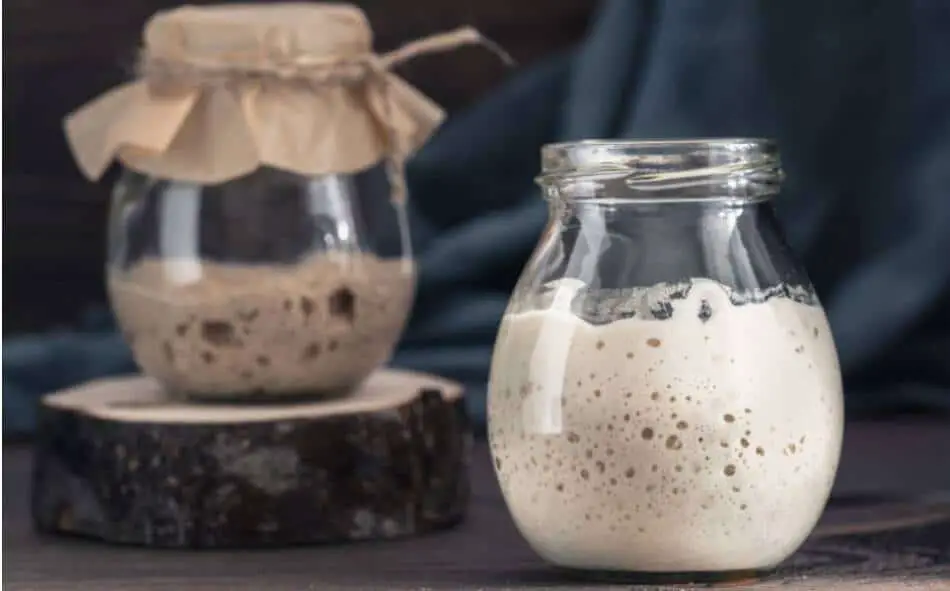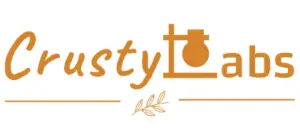Poolish, Biga, and Pate Fermentee use commercial yeast for leavening bread, while sourdough starter depends on natural wild yeast and bacteria. Bread made from commercial yeast (yeasted pre-ferments) is less acidic than sourdough because of fewer acid-producing bacteria, giving it a milder taste. In contrast, sourdough provides a pronounced sour flavor and enhances the structure of weaker doughs.
What is a Pate Fermentee?
Pate Fermentee is the French word for ‘old dough’; it is a piece of fermented dough separated from the final dough after bulk fermentation to be used to leaven the next batch of bread. It is made up of flour, water, salt and commercial baker’s yeast; it is the only yeasted pre-ferment that contains salt.
Once the Pate Fermentee has been separated from the final dough of the day’s bake, the final dough is then scaled, shaped, proofed and bake. The Pate Fermentee can be stored for 8-12 hours at room temperature or up to a few days in the refrigerator before it looses too much of its leavening ability.
What is a Poolish?
Poolish is the Polish word for ‘yeasted pre-ferment’, it is made up of a small portion of flour and water that is fermented using commercial baker’s yeast. Once the Poolish has fully ripen, yeast activity is at the highest, the Poolish is then ready to be incorporated into the rest of the dough to leaven it.
No salt is added to the Poolish as salt slows down the fermentation process. Water content of the Poolish is always kept at 100%, which means the pre-ferment has a looser consistency.
It is widely known that using a Poolish helps with improving the extensibility (ability to stretch) of a dough as protease activity is relatively high in the wet and loose Poolish mixture; protease enzymes makes dough more extensible by hydrolyzing gluten bonds.
What is a Biga?
Biga is the Italian word for ‘yeasted pre-ferment’, it is made up of a small portion of flour and water that is fermented using commercial baker’s yeast. Once the Biga has fully ripen, yeast activity is at the highest, the Biga is then ready to be incorporated into the rest of the dough to leaven it.
No salt is added to the Biga as salt slows down the fermentation process. Water content of the Biga varies in the range of 50% to 100% hydration; the biga can have a stiff or loose consistency depending on its hydration level.

What is a Sourdough Starter?
The sourdough starter is a ‘natural pre-ferment’, it is made up of a small portion of flour and water that is refreshed on a daily basis to strengthen the natural population of wild yeast and bacteria that ferments the mixture; no commercial baker’s yeast is added to the sourdough starter.
After a few weeks of regular feedings, the sourdough starter should be matured enough to leaven bread.
Sourdough starter are made using different combination of flours and hydration levels. However, it is widely accepted that sourdough starters made with Rye flour possesses the greatest leavening ability. For the sake of convenience in calculating the weight of flour and water to be added to the final dough, sourdough starter is typically kept at 100% hydration level; the 1:1 flour to water ratio makes the calculation intuitive.
Differences between a Poolish, Biga and Pate Fermentee
The Poolish, Biga and Pate Fermentee are all yeasted pre-ferments, meaning a small portion of flour is pre-fermented using commercial baker’s yeast before it is incorporated with the rest of the dough. The pre-ferment system allows more time for the accumulation of acid into the dough, which helps to impart complex flavors and tightens the gluten structure resulting in better oven spring.
The only difference between the Poolish and Biga is in its hydration level; the Poolish is always made up of 100% hydration while the Biga ranges between 50% -100% hydration. The Pate Fermentee is unique to the Poolish and Biga, in that it contains salt; no salt is added to the Poolish and Biga.
It is important to know when to incorporate the pre-ferment into the dough, to achieve the best flavor and leavening of the dough. As all three pre-ferments contains varying levels of water content, its indicator of ripeness varies accordingly as well.
The 100% hydration Poolish and Biga has a looser consistency, and ripeness is indicated by many small bubbles on the surface of the culture which is a sign of healthy yeast activity. The Poolish has over ripen when the culture has over risen and fallen, leaving a high water mark on the side of the vessel.
As we go below 100% hydration level, the Biga and Pate Fermentee will have a progressively stiffer consistency. The stiff culture tends to dome in its center as it is rising, and once it has fully ripen, the center of the dome will gently being to recede.
All three types of pre-ferment taste fairly similar once it is incorporated into a dough and baked, given that the same amount of commercial yeast is used. The main difference in flavor is mostly due to the amount of commercial yeast incorporated into the pre-ferment, which directly affects the time it takes the pre-ferment to ripen, and the amount of organic acid produced during that time.
The pre-ferments are made with commercial baker’s yeast in the range of 0.1% to 1% of the total weight of flour in the dough. The less yeast is used, the longer the time it takes the pre-ferment to ripen, which gives more time for organic acids to accumulate to imparts complex flavor to the baked loaf.
Differences between Yeasted Pre-ferments (Pate Fermentee, Poolish, Biga) and Sourdough Starter

1. Commercial baker’s yeast VS Wild yeast and bacteria
The Poolish, Pate Fermentee and Biga are all yeasted pre-ferments, which means commercial yeast is added to the cultures to leaven bread. The sourdough starter is a natural pre-ferment, where no commercial baker’s yeast has been added; sourdough starter relies on wild yeast and bacteria found naturally in the flour and water of the culture for its leavening abilities.
The yeasted pre-ferment (poolish, biga and pate fermentee) once ripen, is made up of predominantly commercial yeast strain as the strong commercial yeast strain out competes other fermentative microbes for nutrients and dominates the culture. The ripe sourdough starter is made up of a balanced population of wild yeast and acid producing bacteria which has the ability to leaven bread and impart organic acids into the dough.
2. The Yeasted Pre-ferment (poolish, biga and pate fermentee) is less acidic than the Sourdough Starter
As the commercial yeast strain dominates the yeasted pre-ferment (poolish, biga and pate fermentee), only a small population of acid producing bacteria survives and imparts less acids into the final dough. The bread made with the yeasted pre-ferment will be less sour than a bread made with the sourdough starter.
The acid producing bacteria in the sourdough starter ferments the dough by consuming simple sugar to produce carbon dioxide and organic acids which imparts a distinct sourness and complexity of flavor to the bread.
The acidity of the sourdough starter also tightens the gluten matrix and strengthens the dough, allowing weaker doughs to better hold its shape; this is especially helpful for very wet doughs and doughs made of high proportion of whole grain flour that tends to severe the gluten matrix.
3. Yeasted pre-ferment (poolish, biga and pate fermentee) leavens bread more consistently than a sourdough starter.
In general, the commercial baker’s yeast used in yeasted pre-ferments is highly active and consistent in its leavening abilities; it is the beginner friendly option as there are less things that can go wrong when using commercial baker’s yeast.
The sourdough starter can be finicky at times; some days it is active and some days it is not. Since its leavening ability can vary from day to day, fermentation times varies accordingly, making the baking process more difficult. The baker must be able to read the dough, correctly identifying when the dough has completed fermentation to prevent overproofing or underproofing the dough.
4. The yeasted pre-ferment (poolish and biga) serves a single use while the sourdough starter is perpetuated indefinitely
The Poolish and Biga is only prepared whenever the baker wishes to bake bread. Once the Poolish and Biga ripens, everything is incorporated into the dough to be baked. The baker has to develop a new batch of Poolish and Biga everytime he wishes to bake.
The sourdough starter on the other hand, is an on-going living culture that requires the baker to maintain the culture with fresh flour and water on a daily basis. The Pate Fermentee is also an on-going living culture similar to the sourdough starter. However, the Pate Fermentee is made up of mostly commercial baker’s yeast while the sourdough starter is made up of wild yeast and bacteria.
On the days that the baker wishes to bake, the sourdough starter is build up to the appropriate weight through multiple feedings, and a small portion of the ripen culture is set aside to be perpetuated for future use. In the case of the Pate Fermentee, up to 1/3 of the dough is separated after bulk fermentation to be incorporated into the next batch of bread.

